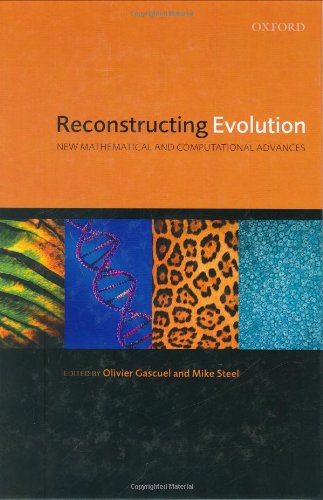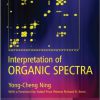Reconstructing Evolution New Mathematical and Computational Advances 1st Edition by Olivier Gascuel, Mike Steel 0199208220 9780199208227
$50.00 Original price was: $50.00.$35.00Current price is: $35.00.
Reconstructing Evolution New Mathematical and Computational Advances 1st Edition by Olivier Gascuel, Mike Steel – Ebook PDF Instant Download/Delivery: 0199208220, 9780199208227
Full download Reconstructing Evolution New Mathematical and Computational Advances 1st Edition after payment

Product details:
ISBN 10: 0199208220
ISBN 13: 9780199208227
Author: Olivier Gascuel, Mike Steel
Evolution is a complex process, acting at multiple scales, from DNA sequences and proteins to populations of species. Understanding and reconstructing evolution is of major importance in numerous subfields of biology. For example, phylogenetics and sequence evolution is central to comparative genomics, attempts to decipher genomes, and molecular epidemiology. Phylogenetics is also the focal point of large-scale international biodiversity assessment initiatives such as the ‘Tree of Life’ project, which aims to build the evolutionary tree for all extant species. Since the pioneering work in phylogenetics in the 1960s, models have become increasingly sophisticated to account for the inherent complexity of evolution. They rely heavily on mathematics and aim at modelling and analyzing biological phenomena such as horizontal gene transfer, heterogeneity of mutation, and speciation and extinction processes. This book presents these recent models, their biological relevance, their mathematical basis, their properties, and the algorithms to infer them from data. A number of subfields from mathematics and computer science are involved: combinatorics, graph theory, stringology, probabilistic and Markov models, information theory, statistical inference, Monte Carlo methods, continuous and discrete algorithmics. This book arises from the Mathematics of Evolution & Phylogenetics meeting at the Mathematical Institute Henri Poincaré, Paris, in June 2005 and is based on the outstanding state-of-the-art reports presented by the conference speakers. Ten chapters – based around five themes – provide a detailed overview of key topics, from the underlying concepts to the latest results, some of which are at the forefront of current research.
Reconstructing Evolution New Mathematical and Computational Advances 1st Table of contents:
I: Evolution in Populations
1 Trees of genes in populations
1.1 Introduction
1.2 Effects of evolutionary forces on coalescent trees
1.3 Inference methods
1.4 Programmes
1.5 The wave of the future
2 The evolutionary analysis of measurably evolving populations using serially sampled gene sequences
2.1 Introduction
2.2 Constructing phylogenetic trees from serially sampled data
2.3 Maximum-likelihood estimation of evolutionary rates
2.4 The serial coalescent
2.5 Estimating population size and substitution rates under the s-coalescent
2.6 Estimating migration rates
2.7 Where to next
II: Models of sequence evolution
3 Modelling the variability of evolutionary processes
3.1 Introduction
3.2 Mathematical tools and concepts
3.3 Biological data sets
3.4 The models in action: analysis of protein coding sequences
3.5 Discussion
4 Phylogenetic invariants
4.1 Introduction
4.2 Phylogenetic models on a tree
4.3 Edge invariants and matrix rank
4.4 Vertex invariants and tensor rank
4.5 Algebraic geometry and computational algebra
4.6 Invariants for specific models
4.7 Invariants and statistical tests
4.8 Invariants and maximum-likelihood
4.9 Invariants and identifiability of complex models
4.10 Other directions
4.11 Concluding remarks
III: Tree shape, speciation, and extinction
5 Some models of phylogenetic tree shape
5.1 Introduction
5.2 Background
5.3 Yule and Hey models
5.4 λ = function(trait)
5.5 λ = function(age)
5.6 λ = function(time)
5.7 The neutral model
5.8 λ = function(N)
5.9 Concluding remarks
5.10 Appendix
6 Phylogenetic diversity: from combinatorics to ecology
6.1 Introduction and terminology
6.2 Definitions and combinatorial properties
6.3 Biodiversity conservation
6.4 Loss of phylogenetic diversity under extinction models
6.5 Tree reconstruction using PD
6.6 Concluding comments
IV: Trees from subtrees and characters
7 Fragmentation of large data sets in phylogenetic analyses
7.1 Introduction
7.2 Basic definitions
7.3 Strategies for handling fragmentation of data sets
7.4 Conclusions
8 Identifying and defining trees
8.1 Introduction
8.2 From biology to mathematics
8.3 Defining trees in terms of chordal graphs
8.4 Defining trees in terms of closure rules
8.5 Identifying trees in terms of chordal graphs
8.6 Identifying trees in terms of quartets
8.7 Conclusion
V: From trees to networks
9 Split networks and reticulate networks
9.1 Introduction
9.2 Consensus networks and super networks
9.3 Split networks from sequences and distances
9.4 Hybridization and reticulate networks
9.5 Recombination networks
10 Hybridization networks
10.1 Introduction
10.2 Hybridization networks
10.3 A characterization of MINIMUM HYBRIDIZATION
10.4 Algorithmic applications of agreement forests
10.5 Recombination networks
10.6 Hybridization networks in real time
10.7 Computational complexity
10.8 Concluding remarks
People also search for Reconstructing Evolution New Mathematical and Computational Advances 1st:
evolution mathematical model
reconstructing scientific revolutions
reconstructing earth’s history
reconstructing more science
Tags:
Olivier Gascuel,Mike Steel,Reconstructing,Evolution



